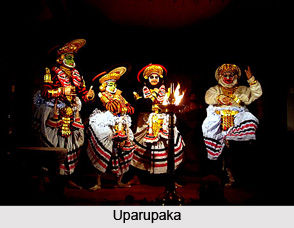 Uparupaka, which is rasa oriented drama, is a form of Sanskrit theatre. This type of theatre form also called `minor drama` came into prominence when Sanskrit drama declined, and they are regarded as the link to the present-day drama forms.
Uparupaka, which is rasa oriented drama, is a form of Sanskrit theatre. This type of theatre form also called `minor drama` came into prominence when Sanskrit drama declined, and they are regarded as the link to the present-day drama forms.
This drama form represents an important landmark in ancient theatre tradition. According to V. Raghavan, the uparupaka evolved from folk dances and folk plays that were "taken, refined, refashioned and fitted into the classical technique and framework."
Depiction of Uparupaka
The uparupaka depicts mostly a short theme, or a self-contained section usually taken from a larger theme. The composition of this drama is simple and the presentation on stage did not demand any elaborate accessories. The importance was given more to the performance. Actually, in this theatre form, the music and dance elements are of more importance and speech minimal.
History of Uparupaka
The uparupakas appear to have emerged from the rupakas, or perhaps they were contemporary with them. The wider and older term rupaka defines the ten major forms. This is possibly derived from actors assuming the form or rupa of characters. The Natyasastra is silent about uparupakas but mentions one dramatic variety, the natika, distinguishing it from the ten rupakas.
Later writers on dramaturgy listed a number of uparupakas. These can be named as natika, trotaka, sattaka, natyarasaka, prasthana, ullapya, kavya, prenkhanaka, rashaka, samlapaka, srigadita, silpaka, vilasika, durmallika, prakarani, hallisa, and bhanika.
In medieval rimes, Abhinavagupta, Bhojadeva, Hemachandra, and Saradatanaya added dombika, dvipadi, samya, prerana, ramakrida, shidgaka, ragakavya, lasya, tandava, chalika, sampa, mallika, kalpavalli, and parijataka.
It appears that uparupakas existed from ancient times and were enunciated by authorities like Harsha. According to Saradatanaya, it defines the trotaka in a commentary, now lost. However, they developed and were performed in the pre-medieval and medieval periods on a large scale. They were predominantly musical and dance forms, alternatively known as sangitakas.
Further research may reveal their exact relationship with the innumerable dance-dramas that evolved all over India, continuing to this day as popular or folk theatre. The uparupakas include medieval plays written in Prakrit, such as sattakas. The pre-medieval and medieval theatre in Prakrit and Apabhramsa may also be understood better by exploring the history and nature of uparupakas as well.




















